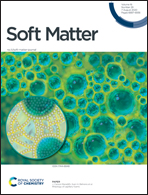Exploring a unified description of the super-Arrhenius region above and below the glass transition temperature†
Abstract
A new approach is presented in order to check whether the hypothesis of an Arrhenius component surviving in the α-relaxation region is consistent with experimental data. The temperature dependence of the dynamics in the whole glassy regime is described by an equation which assumes an Arrhenius component in the cooperative diffusion. Based on thermodynamic arguments, the dynamic heterogeneities close to the glass transition region are related to structural heterogeneities in a manner consistent with the idea of a sigmoidal shape in the cohesion energy. By doing so, a characteristic temperature which can be identified as the glass transition temperature (Tg) emerges, while an additional parameter for the extension of the super-Arrhenius region is introduced. In the analysis of experimental data, the activation energy parameter, determined from the temperature dependence of the β-relaxation, is fixed, and the relation between the experimental and the predicted glass transition temperature is examined. The results of this comparison support the idea that dynamics above and below Tg can be described in a unified manner. The proposed model is tested against experimental data of glass-forming liquids, polymers and polymer composites. In the latter systems, it is shown that the Arrhenius-like behavior characterizing the dynamics of the polymeric bound-layer can be accounted for by such an extension of the super-Arrhenius region.



 Please wait while we load your content...
Please wait while we load your content...